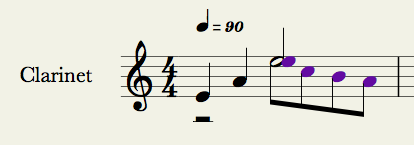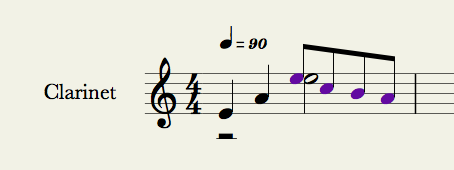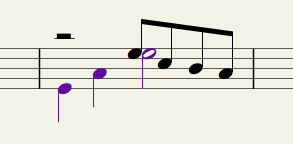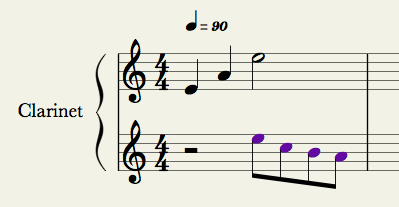I am guessing that there is a specific reason for having two voices on one staff, since the obvious solution is to put each voice on a separate staff . . . So, I did a few experiments, and I see no way to avoid the problem of trying to fit two things into the same space . . .
[
NOTE: For contextual reference, this is a screen capture of the problem as observed in the NOTION score you posted (see above) . . . ]

Nevertheless, if you explicitly change the stem direction for the eighth notes as a set to "stem up" and then change the stem direction for the half note to "stem down", this provides a nice solution . . .

You could reverse the voices, which works for this particular measure, but whether it will work in other scenarios depends . . .

However, in one experiment I changed the single staff to a grand staff; selected the second voice (purple) and cut it, followed by pasting it to the bass staff. Then I changed bass staff to a treble staff, thereby creating a double-treble grand staff . . .
[
NOTE: This is based on something I discovered earlier today about switching a single staff to a grand staff'; and it is an interesting technique to use when working with two voices on a single staff, where the strategy is temporarily to change the single staff to a grand staff, followed by doing the cut and paste step, and then making the bass clef a treble clef. This way you can work with each voice separately but merge them back to a single line later, and then go back-and-forth easily, with the only requirement being to remember to change the bass clef to a treble clef each time you switch to a grand staff. And this technique works with the other types of clefs, since software engineers understand mathematics and are not going to write a separate and independent algorithm for each type of clef. Instead they most likely get it working for the treble clef and then add conditional code to make it specific to the other clefs based on algebra or whatever, which is one of the reasons I do nearly everything with soprano treble clef staves, which combined with transposition, is mathematically elegant as compared to having a virtual festival of different clefs, which mostly is a big mess and certainly is not mathematically elegant. There are 12 notes and 10 or so octaves nearly all the time here in the sound isolation studio, and I put all of them on soprano treble clef staves, which keeps everything very simple . . . ]

This makes it easier to work with the notes, and if you change the grand staff back to a single staff the two voices are on the same staff . . .
However, if you repeat the process, you need to change the bass staff to a treble staff. The split notes stay on the "bass" staff, so you do not need to redo that part . . .
From my perspective, no matter how it is done, multivoice parts are a bit messy visually unless the note for each voice is sufficiently different but with identical timing and duration, which essentially is like playing chords on a piano, where there is only one specific key for each note (hence no collisions) . . .
Summarizing, I think this is the way it is, and except for putting each voice on a different staff; using a custom double-treble grand staff; swapping voices; or adjusting note stem directions, I have not found any other solutions, although one of these four solutions should work . . .
Lots of FUN! 



